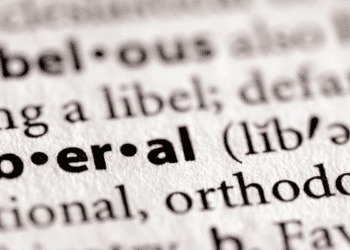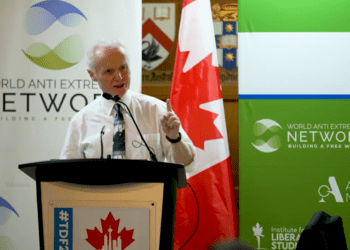By Colin Woodard, July 9, 2025
On the surface, the political courses of North America’s two wealthiest countries haven’t been this divergent since Canadian confederation in 1867.
South of our shared border, a majority of voters in America’s fall 2024 presidential election saw fit to return to power a convicted felon who was about to face trial for his role in a violent coup attempt. He’s now arresting judges and lawmakers, deploying active-duty troops in his nation’s cities, threatening Canada and Greenland with annexation, and rapidly dismantling the rules-based order the U.S. helped establish after the Second World War.
North of the border, the spring 2025 Canadian general election saw voters keep the Liberals in power behind a leader who centered his campaign around a pledge to stand up to Trump, and stand in support of the western alliance.

Look beneath the surface, however, and political developments start looking a lot more similar.
Our countries share the fact that they are awkward federations comprised of distinct regional cultures with aspects of nationhood – a legacy of rival European colonial projects in North America. And by that, I don’t mean simply those of France, Spain, the Netherlands, and Britain. These regions are also shaped by the intense rivalries and differences between British colonial cultures – be they New England Puritans, multireligious Midlanders, or lowland slaveholders.
Indeed, modern political developments make a lot more sense when viewed through the regional identities that are the legacy of these 17th-, 18th-, and early 19th-century colonial projects.
In my 2011 book, American Nations: A History of the Eleven Rival Regional Cultures of North America, I explained how mutually exclusive bands of immigration shaped respective regions of Canada, the U.S., and Mexico. This history imbued each region with distinctive civic and religious institutions, cultural norms, and ideas about freedom, social responsibility, and the provision of public goods. Later arrivals would encounter and, by and large, assimilate into these regional cultural tendencies. Importantly, these settlement streams – whose members were often repelled by one another’s values and practices – spread with little regard for today’s state, provincial, and international boundaries, not least because many of these borders didn’t exist until well after the fact.
Those colonial projects – Puritan-controlled New England; Samuel de Champlain’s colonies in Acadia and the Saint Lawrence valley; the Dutch-settled area around what is now New York City; the Quakers’ beachhead in the Delaware Valley; the Scots-Irish-dominated upland backcountry of the Appalachians; the West Indies-style slave society in the Deep South; the Spanish project in what is now Central America, Mexico, and the Southwestern U.S. and so on – had different religious, economic and ideological characteristics. They settled large parts of this continent in mutually exclusive settlement bands before significant third party in-migration picked up steam in the 1840s. In the process – as I unpacked in American Nations – they laid down the institutions, cultural norms, and ideas about freedom, social responsibility, and the provision of public goods that later arrivals would encounter and, by and large, assimilate into.
The information box below describes the regional cultures in brief, but a more detailed summary can be found here.
Some states, provinces, and territories lie entirely or almost entirely within one of these regional cultures (Nova Scotia, Mississippi, Vermont, Minnesota, Alberta, Montana, and Nunavut, for instance). Others are split between the regions, propelling constant and profound internal disagreements on politics and policy alike in places like Pennsylvania and Illinois, California and Ohio, New Brunswick and British Columbia.

For the past thirty years or more, U.S. politics has been dominated by a struggle between regional blocs. There is a “red” coalition of three nations, each with cultures that see freedom’s path lying almost exclusively with individual liberty and personal sovereignty: Greater Appalachia, Deep South, and the Far West. It’s squared off against a “blue coalition” of regions where the culture emphasizes the need to uphold the common good: Yankeedom, New Netherland, and the Left Coast.
Over the past two decades, two would-be swing nations have tentatively have joined the “blue” camp. El Norte, the far-flung borderlands of the Spanish American empire, has conservative bones but shifted left in the early aughts in reaction to the Republican’s growing ethnonationalism. Tidewater, once the bastion of the Confederacy, has become safely Democratic after decades of massive in-migration driven by the federal government’s presence in D.C. and Hampton Roads, home of the world’s largest naval base. A third, the Midlands, has always been the most competitive region of all, balanced between its middle-class orientation – that society should be organized to benefit ordinary people – and its skepticism of even the mild sort of top-down government intervention favoured in Yankeedom or the Left Coast.

And what of Canada? A look at April’s federal elections through a regional lens reveals a similar dynamic at work, only with a very different mix of regions.
At Nationhood Lab, we coded all of Canada’s current federal ridings by their dominant American Nations culture and then totaled the votes cast by party in each. The Canadian election results map (first map in this article) reveals which party’s candidates received the most votes in each “nation” and their margin of victory over the runner-up party.
You can see the Liberals won every region save the Far West, resulting in a center-left government even as the United States has put an extreme right wing political movement in control of Washington. The reason for this is that Canada doesn’t have the Deep South and Greater Appalachia – two ultra-conservative regions with legacies of slavery and segregation where Trumpism has its most solid support. That leaves the (far more moderate) Far West region as Canada’s conservative outlier – the birthplace and stronghold of former Conservative prime minister Stephen Harper’s political enterprise. Trump’s radical ethnonationalism rubs many Far Westerners the wrong way, which is why he only won the region by 9.5 points. A center-right formation like the Conservative Party of Canada is much more in sync with this region’s libertarian-but-accepting culture, which helps explain why the Tories won Canada’s Far West section by a whopping 35.2 points, the most lopsided margin of victory on the continent.
As in the U.S., the Midlands was the most competitive region in Canada’s April elections, going for the Liberals by 5.8 points. Populism has proven pretty popular there. The U.S. section of this region went for Hillary Clinton by 0.6 points in 2016, Biden by 3.1 in 2020, and for Trump by 0.5 last November. It’s, of course, the birthplace of “Ford Nation” which, in sync with the Midland’s multi-cultural character, manages to appeal to immigrant voters.
In both federations, communitarian Left Coast and Yankeedom are progressive, though rural Yankeedom has proven less resistant to ethnonationalism than it was to the traditional Republicans’ laissez-faire individualism. In the U.S., Trump lost these regions by 37.2 and 10.7 points respectively in 2020, and by 33.3 and 6.1 in 2024. But he moved rural Yankee counties from +5.9 Democratic in the 2008 election (Obama vs. McCain) to +19.3 Republican in 2024. Similarly, in Canada’s 2015 election, Liberals won all 25 ridings in Yankeedom, but this year they lost five rural ones in Nova Scotia and New Brunswick and scored an overall victory margin of +17.1 points.
Left Coast’s “liberal” margins are higher when you take into account the performance there of the New Democratic Party. The NDP was nearly wiped out on the federal stage in April, but it held its three seats in British Columbia’s Left Coast section, where the pro-environment Greens scored their only seat. Those two parties account for more than 13 per cent of the section’s vote, their largest combined share in any region.
While Canada lacks a conservative “Dixie bloc” – and, therefore, a legacy of slavery and apartheid – it has three large, strongly communitarian regions that leave little or no footprint within the United States, pulling its center of gravity well to the left of ours.
The most consequential of these is New France – southern Quebec and parts of New Brunswick – a region with a strong social democratic tradition, complete with powerful trade unions and state-owned hydroelectric, investment, casino, and alcohol distribution corporations. The U.S. enclave of New France – in southern Louisiana – has been politically absorbed by the Deep South surrounding it, but its Canadian “homeland” very much has not. In April, its voters gave the Liberals their largest victory margin – 28.3 points – and relegated the Conservatives to third place, behind the secessionist Bloc Québécois.
In the U.S., Indigenous-dominated First Nation is confined to a small enclave of just 62,000 people in northern and western Alaska – too small to have much bearing on federal politics. But in Canada, First Nation is a sprawling region almost as big as the continental United States comprising hundreds of thousands of people and dominating two territories, Nunavut and the Northwest Territories. It voted for the Liberals by a nearly 18-point margin, mirroring northern and western Alaska’s strong preference for Democrats.
Finally, there’s a culture only found in Canada: that of the unique, 400-year-old Anglo-Irish of Newfoundland – which reluctantly joined the federation after the Second World War – along with southern Labrador. This rural region, distinct from the Yankee Maritimes, has a neighbourly, communitarian ethos and a history of social democracy (under their colourful first premier, Joey Smallwood), and usually votes similarly to Canadian Yankeedom. This spring, it gave the Liberals a 15.5-point victory, but with a strong urban/rural split. Whereas in 2015, every riding in the region went for the Liberals, this year only Labrador and the relatively urbanized Avalon Peninsula did so, the while the other three, very rural, ridings elected Conservatives to represent them in Parliament.
The bottom line is that Trumpism is a non-starter on the Canadian federal stage. The regional cultures that are behind its rise to power in the United States simply aren’t present north of the border, while the cultures most open to conservative governance – the Midlands, Far West, and Yankeedom — are all more aligned with the center-right than its radical alternative.
Colin Woodard is the director of Nationhood Lab at Salve Regina University’s Pell Center for International Relations and Public Policy, and the author of seven books including American Nations: A History of the Eleven Rival Regional Cultures of North America and Nations Apart: How Clashing Regional Cultures Shattered America, forthcoming Nov. 4 from Viking/Penguin.






